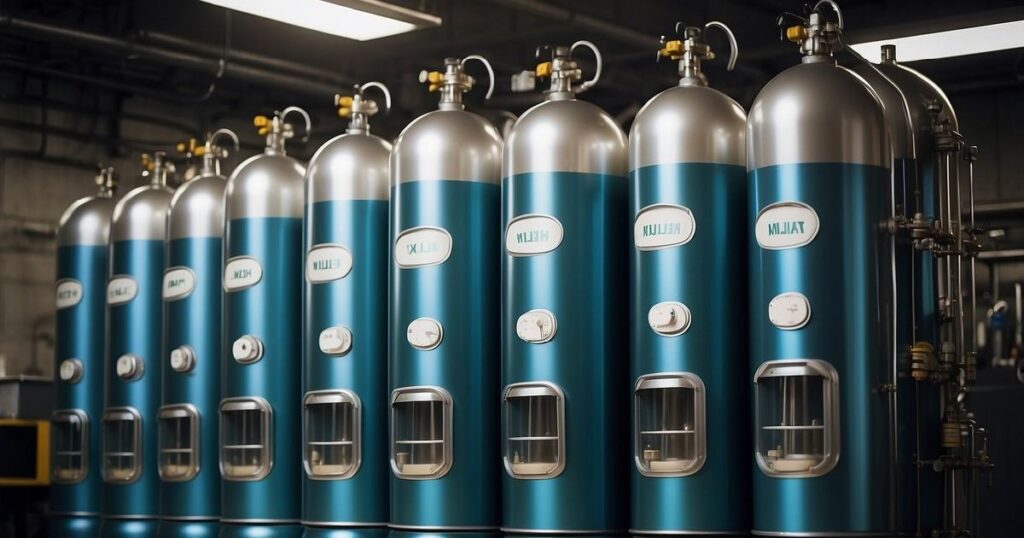Helium gas technology is at the forefront of various advancements, influencing everything from scientific research to cutting-edge manufacturing processes. This unrenewable noble gas, primarily produced from natural gas, boasts unique properties that make it invaluable in many sectors. One of the key innovations in helium gas technology is the use of membrane technology, offering a promising alternative for helium recovery and purification due to the distinct differences in kinetic diameters between helium and other gases like nitrogen and methane.
In scientific research and energy, helium plays a crucial role, especially in cooling the superconducting components required for quantum computing and quantum communication. Such applications depend on liquid helium’s precise cooling abilities, underscoring its irreplaceable value. As these emerging technologies develop, the demand for helium will inevitably grow, driving further innovations in how this finite resource is utilised and managed.
Healthcare technology is another domain benefiting significantly from innovations in helium gas technology. Medical instruments increasingly leverage helium’s excellent cooling properties to enhance performance and reliability. With the global helium shortage posing challenges, effective helium recycling and conservation strategies become more critical than ever. By exploring these cutting-edge advancements, you can better appreciate how helium gas technology continues to shape future industries.
Advancements in Helium Extraction and Processing Technologies

Recent innovations in helium gas technology focus on improving extraction methods, enhancing purification processes, and promoting sustainability through recycling practices. These advancements aim to address the scarcity and environmental impact of helium, a finite resource critical for various applications.
Innovative Methods of Helium Extraction
Helium extraction has seen significant strides with the use of membrane technology. Membranes made from materials like polybenzimidazole (PBI) exhibit high selectivity and permeability rates, enabling efficient separation of helium from natural gas reserves. This method reduces energy consumption compared to traditional cryogenic processes.
Novel poly(p-phenylene benzobisimidazole) membranes offer even higher performance, ensuring maximum recovery from natural gas. These materials can withstand harsh operational conditions, ensuring durability and efficiency. Helium extraction from off-gas produced during conventional natural gas processing is another area with the potential to enhance overall recovery rates.
Progress in Helium Purification and Quality Management
Advances in purification techniques are essential for maintaining the high-quality standards of helium. Improved membrane materials and processes are critical in achieving high purity levels. Polymer-based membranes like PBI provide superior permeability and selectivity, ensuring effective removal of impurities.
Quality management incorporates real-time monitoring systems to detect and maintain purity levels. These systems involve sophisticated sensors and analytical tools that measure and manage helium quality during processing. Ensuring consistent purity is vital for applications in scientific research, medical treatment, and industrial production.
Helium Recycling and Sustainability Practices
With helium being a finite resource, recycling practices have gained prominence. Recycling efforts focus on capturing helium from various industrial processes and repurposing it. This not only conserves natural gas reserves but also reduces environmental impact.
Implementing recycling systems in industries that use large quantities of helium, such as MRI manufacturing and semiconductor production, is increasingly common. Sustainable practices also include developing policies that encourage the conservation and efficient utilisation of helium. These initiatives are essential for ensuring the long-term availability of this crucial element.
By adopting these advanced technologies and sustainable practices, you can help ensure that helium remains available for future generations while minimising environmental harm.
Diverse Applications of Helium Across Industries

Helium is indispensable in various fields due to its unique properties, such as low boiling point and inertness. This section explores its pivotal role in healthcare, advanced material manufacturing, aerospace technologies, and emerging high-tech applications.
The Critical Role of Helium in Healthcare
Helium is vital in medical imaging, particularly in MRI scanners. It acts as a cooling agent for the superconducting magnets, which are essential for the machine’s function. Cryogenics in healthcare also relies heavily on helium, leveraging its extremely low temperature to preserve biological samples.
In respiratory medicine, helium-oxygen mixtures improve airflow for patients with obstructed airways. This application underscores the importance of helium in critical medical interventions.
Helium in the Manufacturing of High-Tech Materials
In the manufacturing sector, helium plays a crucial role in producing semiconductors, ensuring the efficiency of processes that require an inert atmosphere. Germanium and silicon wafer production benefit significantly from helium’s properties.
Helium is also used to produce optical fibres, which helps cool the fibre during the drawing process and prevents imperfections. Its role in laser welding of metals ensures high precision and quality when joining advanced materials.
Utilisation of Helium in Space and Aerospace Technologies
Helium’s applications extend to aerospace and space exploration. It is used as a pressurising agent in rockets, ensuring fuel systems remain functional under extreme conditions. In spacecraft, helium purges and pressurises propulsion systems.
Helium’s cooling capabilities are critical for cryogenics in the space industry. Helium-cooled detectors and instruments ensure the precision of astronomical observations and space missions.
Emerging Use Cases: From Superconductors to Deep-Sea Exploration
New applications of helium are continually emerging, particularly in the realm of superconductors and deep-sea exploration. In fusion research, helium cools superconducting magnets, enabling efficient energy generation.
Helium’s low viscosity makes it ideal for underwater regions, providing efficient gas flow without turbulence. This property is pivotal in advancing deep-sea exploration technologies, including underwater welding and remote-operated vehicles (ROVs).
Frequently Asked Questions
This section addresses pressing concerns about helium gas technology, including solutions to shortages, price trends, and potential future advancements.
What strategies are being implemented to address the global helium shortage?
Researchers are looking into alternative helium sources, such as natural gas fields, and pursuing innovative separation techniques. Membrane technology is an emerging method aimed at improving efficiency in helium recovery.
How have helium prices fluctuated over the past decade?
Helium prices have changed considerably, with costs initially high due to limited supply and increasing demand. The price trend indicates a gradual decrease as new sources and more efficient technologies emerge.
In what ways can we reduce helium consumption in industrial applications?
To make industrial helium use more efficient, you can consider methods like recycling, optimising process efficiency, and exploring substitute materials where possible. Equipment upgrades and better management practices also contribute to reduced consumption.
What advancements are anticipated in the recycling of helium gas?
Future technological advancements in helium recycling are likely to focus on improving capture and refinement processes. Enhanced purification systems will make helium recovery more viable and cost-effective for industrial applications.
How might alternative technologies impact the demand for helium in the future?
Emerging technologies, such as hydrogen-based cooling systems in superconducting applications, might reduce dependence on helium. Alternative materials and innovations could further change the landscape, potentially lessening helium demand.
What role do geological surveys play in identifying new helium sources?
Geological surveys are crucial for locating new helium reserves, often found in natural gas fields. These surveys employ advanced imaging and analysis techniques to evaluate potential sites, thus playing a vital role in expanding the helium supply.


